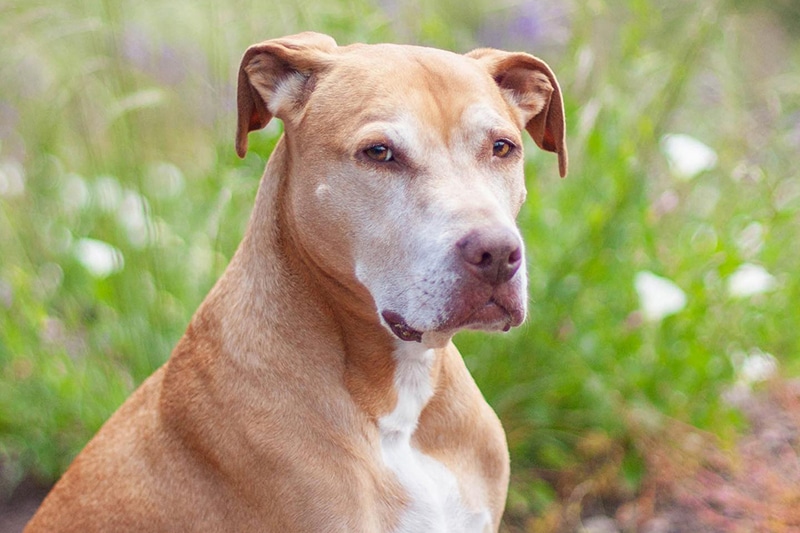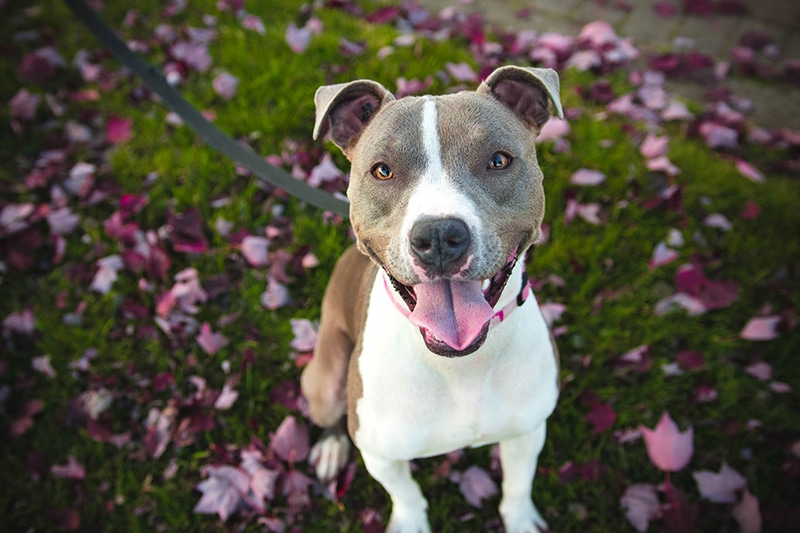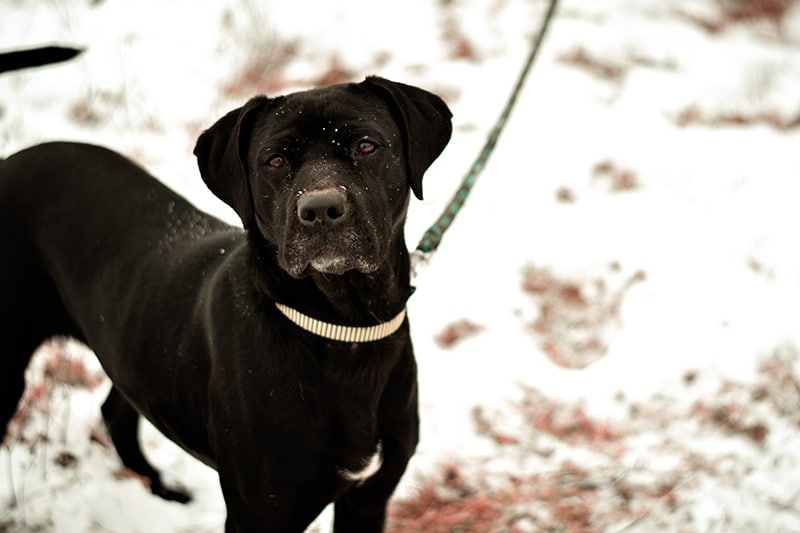The Pitbull Boston Terrier, otherwise known as the Boston Pit, or the Terrier Pitbull, is a medium-sized mixed-breed dog created by breeding the American Pit Bull Terrier and the Boston Terrier.
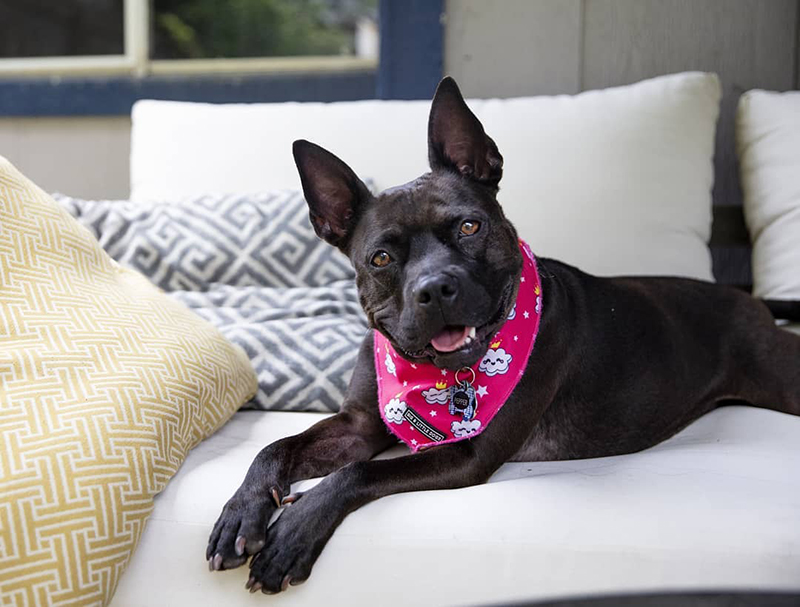
Pitbull Boston Terrier Mix – At a Glance
| Weight: | 30 – 60 pounds |
| Height: | 17 – 20 inches |
| Lifespan: | 9 – 12 years |
| Coat Colors: | White, black, fawn, brindle, black & white, tri-colored |
| Temperament: | Quirky, social, active, family-oriented, cheerful, happy-go-lucky |
| Most Suitable For: | Families with older children or without children, single individuals |
What Does a Pitbull Boston Terrier Mix Look Like?
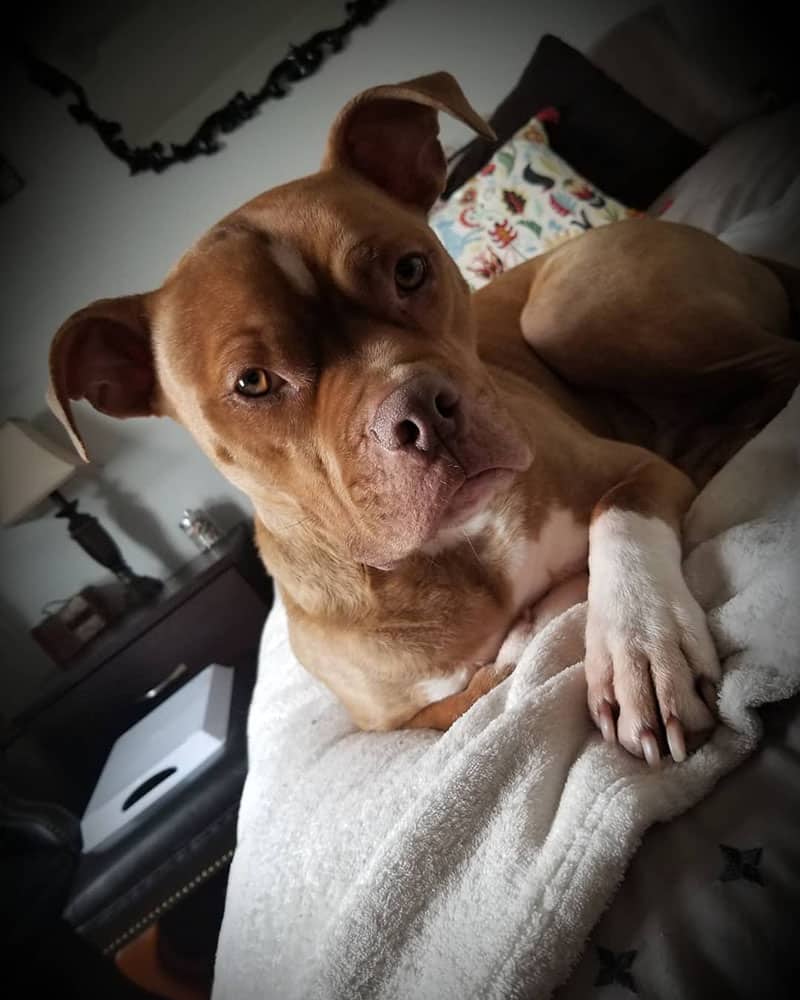
Like many designer dogs, the Pitbull Boston Terrier mix will borrow different parts of its physical appearance from each parent breed. You can Boston Terrier Pitbull to be a medium-sized dog, with a longer body than your traditional Boston Terrier and thinner legs than your traditional American Pit Bull.
Your Boston Terrier Pitbull mix will either inherit the upright ears of the Boston Terrier, or the triangular forward-folding ears of the American Pit Bull Terrier. Your Boston Terrier Pitbull mix may also have a shorter tail.
When it comes to coat colors, you can expect your Boston Terrier Pitbull mix to be either white and black or a tri-colored white, black, and brindle mix. In any case, expect your Terrier Pitbull mix to have the traditional white markings of both breeds.
Are you looking for a way to treat your furry friend? Sign up for our newsletter for a chance to win a free month of Barkbox!
The History of the Pitbull Boston Terrier Mix
Unfortunately, due to the recent development of the Pitbull Boston Terrier mix, not much is known about the history of the Boston Terrier Pitbull mix. We do know that it was likely developed in the 1990s and early 2000s, when crossbreeding became a big deal in the canine landscape of the United States.
To learn more about the Boston Pit, we’ll explore each parent breed’s histories, temperaments, and popularity. This will give you insight into where the Boston Pit fits in the modern mixed-breed landscape of the United States.
The History of the Boston Terrier
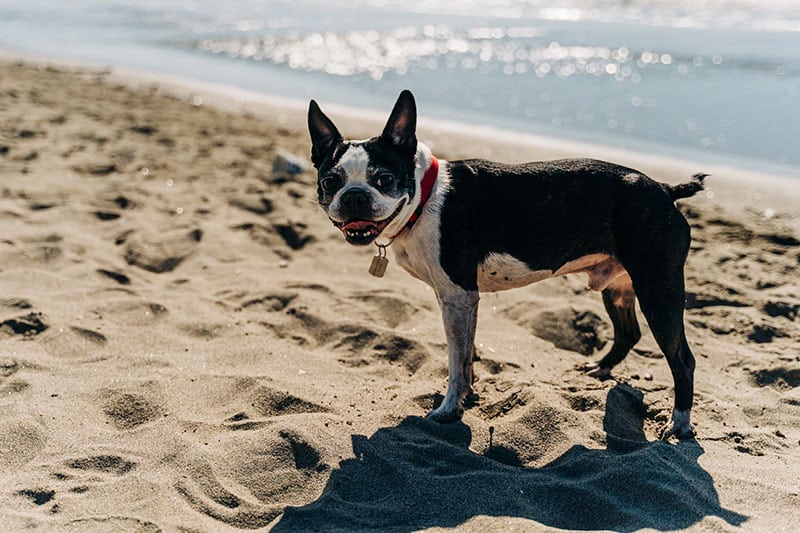
The Boston Terrier’s history begins in the late 19th century, when a man by the name of Robert C. Hooper purchased a Terrier named Judge. Judge’s lineage stretches back to the original bull and terrier mixes in England. Judge was then bred to another dog named Gyp – a white English Bulldog.
The breed became so popular by the late 1880s that the Boston Terrier Club was formed, and in 1893, the American Kennel Club recognized the breed as the Boston Terrier. Known for its round head, Boston Terriers were well-established as family pets by the 20th century.
Boston University used to use Boston Terriers as their mascots and it is the official state dog of Massachusetts.
How Popular Are Boston Terrier in the United States?
Since their introduction to the United States in the late 19th century, Boston Terriers have become one of the nation’s most beloved dogs. Also known as the “American Gentleman,” thanks to their coat color pattern and ‘suit jacket’ appearance of their chest (broad white markings with black accents), the Boston Terrier is a popular family pet.
In 2021, Boston Terriers ranked as the 23rd most-popular dog in the United States, according to the American Kennel Club’s annual popularity rankings.
Who Are Boston Terriers a Good Dog For?
Boston Terriers are well-known as sweet, good-natured dogs without an aggressive streak (except to protect territory). Their small size and obedient nature makes them an excellent fit for most families. They are also popular among apartment dwellers and the elderly due to their size.
However, those living in apartments should be aware that the Boston Terrier can suffer from separation anxiety and bark excessively. Separation anxiety can be trained out of a dog, but you need to be prepared to take that time and train them properly – if their excessive barking becomes problematic in a shared space.
How Did Boston Terriers Come About?
The modern Boston Terrier is the result of crossbreeding between a bull-and-terrier-type dog named Judge and a white Old English Bulldog female named Gyp in the late 19th century.
When Did We First Cross-Breed The Boston Terrier?
Modern crossbreeding of the Boston Terrier likely began sometime during the 1990s or early 2000s, when crossbreeding became popular throughout the United States.
There are a few popular crossbreeds of the Boston Terrier. These include:
- Dachshund Boston Terrier Mix (Bo Dach)
- Corgi Boston Terrier Mix (Boston Corgi)
- Cocker Spaniel Boston Terrier Mix (Boston Spaniel)
- Blue Heeler Boston Terrier Mix (Boston Blue Terrier)
The History of the Pitbull

The Pitbull – or the American Pit Bull Terrier has an unfortunate history that began in England in the late 18th century. Descendants of the Olde English Bulldog and Old English Terrier, the Pitbull was originally bred for use in blood sports – including ‘bull-baiting’ and dog fighting. These ‘sports’ were popular among the English during this time, but were eventually outlawed in 1835.
Following the outlawing of bull baiting as a sport, the Pitbulls present in England were imported to the United States, sometime between 1845 and 1860, where they were used for dog fighting by the newest migrants to the country.
As dog fighting became illegal some decades later, Pitbulls became known as American Pit Bull Terriers and were recognized by the United Kennel Club – but not by the American Kennel Club. The term “Pit Bull” has become something of a catch-all term for many bull-and-terrier type breeds.
The American Pit Bull Terrier currently finds itself in murky legal waters in the United States and much of the Western world. Many countries have outright banned Pitbull ownership – including many U.S cities, though no U.S states have done so.
How Popular Are Pitbulls in the United States?
Despite their shaky legal status, Pitbulls remain popular American household pets. While no AKC statistics exist, other sources indicate that the American Pit Bull Terrier is roughly 20% of America’s ‘strong dog’ population.
Who Are Pitbulls a Good Dog For?
Pitbulls are medium-sized dogs with the strength and power of a dog much larger than they are. They have broad chests and muscular bodies that make them a handful to walk, unless you are strong enough to control them.
This makes them almost impossible for the elderly owner. Pitbulls also tend to suffer from separation anxiety and can exhibit destructive behavior as a result. This makes them largely unsuitable for apartment dwellers too.
In general, Pitbulls are most suited to families with a house and a yard, and those who are strong enough to handle them on a walk.
How Did Pitbulls Come About?
Pitbull Terriers were first bred from the Olde English Bulldog and the Old English White Terrier in the 19th century. Bred to participate in the ‘sport’ of bull-baiting, the Pitbull unfortunately experienced much violence in the early decades of the breed’s existence.
It wasn’t until after 1835 (when bull-baiting was outlawed) that the Pitbull began a new life – mostly in the United States – as the American Pit Bull Terrier. Today, the Pitbull is a popular companion pet, state mascot, and symbolic of toughness and determination. They have also found roles as police dogs.
When Did We First Cross-Breed The Pitbull?
Given it’s murky legal status, some breeders will use crossbreeding of Pitbulls to circumvent specific legislation prohibiting their ownership. This, along with the Pitbulls toughness and endurance as a breed has made them a popular purebred parent for mix breeding.
In modern American history, the Pitbull was likely crossbred for the first time in the 1990s and early 2000s. This led to many popular Pitbull crosses, including the following mixed-breed dogs:
- Pitbull Catahoula Mix (Pitahoula)
- Pitbull Yorkie Mix (Yorkie Pit)
- Pitbull Rhodesian Ridgeback Mix (Rhodesian Pit)
- Pitbull Jack Russell Mix (Jack Pit)
- Pitbull Beagle Mix (Beagle Bull)
How Important Is a Dog’s Temperament to Your Family?
One of the most important things you’ll do before acquiring your newest family member is to research their temperament. This will be an informative process that will help you decide which dog might be the best fit for your family based on (among other factors) whether or not it matches your family’s temperament.
If you’re an active family that likes to be outdoors, you will want an active companion, like a Siberian Husky, Rottweiler, or Great Pyrenees. If you’re looking for a protector, you’ll want to get a Pit Bull Terrier, Bullmastiff, or German Shepherd. Essentially, you’ll want to ensure that the dog you get matches the activity levels and state of your current family unit.
What is the Temperament of the Pitbull Boston Terrier Mix?
The Boston Terrier Pitbull mix will inherit a bit of both temperaments of it’s parent breeds. You can expect your Boston Terrier Pitbull mix to be a pleasant, friendly and affectionate dog among those it considers friends. It may slightly more wary of strangers and display aggression when protecting it’s territory from other dogs.
You might also notice a bit of a stubborn streak in your Boston Terrier Pitbull mix, though this can be corrected with training.
Is The Pitbull Boston Terrier Mix Friendly?
In general, you can expect the Pitbull Boston Terrier to be an affable and loving dog that’s very affectionate with friends! They can sometimes be a lap dog, despite their larger-than-traditional size.
Is The Pitbull Boston Terrier Mix Easy to Train?
Despite the Pitbull’s excitability and stubbornness, you’ll likely find the Boston Terrier Pitbull mix relatively easy to train.
Positive reinforcement training techniques should be used if you’re experiencing difficulties with training.
How Much Can A Pitbull Boston Terrier Mix Weigh?
The average weight of a Pitbull Boston Terrier mix is between 30 and 60 pounds.
How Tall Can A Pitbull Boston Terrier Mix Get?
The average height of a Pitbull Boston Terrier Mix is between 17 and 20 inches tall.
Similar-Sized Breeds
There are a few similar-sized breeds to the Boston Pit. These include:
- Chow Chow
- Basset Hound
- French Bulldog
- English Bulldog
Does the Pitbull Boston Terrier Mix Shed?
You can expect your Boston Pit to be a relatively low-shedding dog, with a short, dense coat. This will likely need brushing either weekly or bi-weekly.
How Much Exercise Does A Pitbull Boston Terrier Mix Require?
You can expect your Boston Pit to require a moderate amount of exercise. Up to 45 minutes daily is plenty, although mental stimulation is also an important part in giving your Boston Pit a healthy life.
Mental stimulation can be found in a game of fetch, or an in-house toy, such as a small KONG-type toy.
How Long Can a Pitbull Boston Terrier Mix Live?
The average lifespan of a Pitbull Boston Terrier mix is between 9 and 12 years.
What Health Conditions Could the Pitbull Boston Terrier Mix Have?
- Corneal Ulcers (Eye Condition)
- Cherry Eye (Eye Condition)
- Patent Ductus Arteriosus (Congenital Heart Disease)
- Brachycephalic Obstructive Airway Syndrome (Brachycephalic Syndrome)
- Ear Infections
- Elbow Dysplasia (Elbow joint inflammation)
- Hip Dysplasia (Hip joint inflammation)
How Can You Find a Pitbull Boston Terrier Mix Puppy For Sale?
If you’ve been searching for a Terrier Pitbull mix puppy to buy, you could begin by searching your local vet clinic or animal shelter for a Pitbull Terrier for to adopt instead!
The Pitbull Terrier mix might be available for adoption online, if you’ve come up empty thus far. Try browsing AdoptAPet.com, which allows you to search your local area for adoptable dogs.
How Much Does a Pitbull Boston Terrier Mix Puppy Cost?
The average price of a Terrier Pitbull mix is between $300 and $1200! The upper end of that price scale is more than double the cost of your typical adoption of a Terrier Pitbull mix.
If you’re still interested in purchasing a Terrier Pitbull mix, consider reading our article on finding a responsible breeder and avoiding puppy mills.
Is the Pitbull Boston Terrier Mix the Right Breed For You?
Whether or not the Boston Pit is the right dog for you is a hugely personal decision, based on whether or not you think you can offer the Boston Pit Bull a great life – filled with love and joy – and are able to fulfill the exercise requirements of this medium-sized pup.
If you’re sure that the Pitbull Boston Terrier isn’t the right breed for you, however – then consider reading our dozens of other breed guides to find a more suitable mix.

